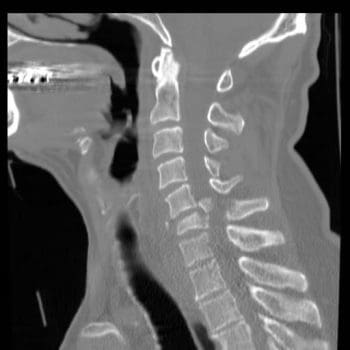A Burst Fracture
A burst fracture describes an injury to the spine where the vertebrae get compressed severely. These types of injuries occur from severe trauma, like an automobile accident or a serious fall, sports injury, work injury. These injuries entail a great deal of force into the spine, so much so that a vertebra can get crushed.When crushed in the front of the spine, a wedge-shaped fracture occurs and is known as a compression fracture.
But if the vertebral body gets crushed in all directions this is known as a burst fracture.
The term burst means that the vertebral body spreads out in all directions.
Severe Injury
This is a much more severe injury than a compression fracture. With the bones crushed and possible rough jagged edges, if they spread out the spinal cord has a high probability of being injured. The fragments can bruise the spinal cord causing paralysis or partial neurologic injury. The spine becomes far less stable than from a compression fracture.Nerve Injury
Neurologic injuries from a burst fracture can range from no injury to paralysis. This depends on the amount of force present at the time of the injury and how much the spinal canal is compromised.- A greater amount of force equals more bony fragments that can be forced into the spinal canal and cause higher loss of spinal cord function.
- Strength
- Sensation
- Reflexes below the injury
With a mild burst fracture, only short-term symptoms could be present and no neurologic injury.
Intense Pain
Burst fractures can cause intense pain and the pain is right where the trauma took place.But pain can also present in the legs and feet depending on how the spinal nerves were affected, shifted or pinched. Patients complain of an electric tingling or shooting type sensation in their legs with spinal cord compression. With a burst fracture, individuals are unable to walk right after the trauma. But the pain percentage present is severe enough that they know not to try and walk.
Diagnosis
If at the sight of the accident the patient says that they have severe back pain should not be in a seated flexed position. They need to be kept lying flat and transported in a flat position.If they stand or sit with a burst fracture, it can increase the possibility of a neurologic injury.
Burst fractures require immediate medical attention from an orthopedic or neurosurgeon. The patient is taken to an emergency room and x-rays, CT scans are gathered.
The diagnosis of a burst fracture is typically made with x-rays and a CT scan.
Sometimes, an MRI will be ordered to assess the amount of:
- Soft tissue trauma
- Bleeding
- Ligament injury
- Compression fracture
- Burst fracture
- Fracture-dislocation
The physical exam will document:
- Spinal deformity and Angulation of the spine
- Tenderness of the spine where the fracture is located
- Neurologic exam
- Muscle strength
- Sensation
- Reflexes of the lower extremities
- Testing of bowel and bladder control
Treatment & Recovery
A stable burst fracture can be treated without surgery.A stable burst fracture falls into these parameters:
- There is no neurologic injury
- The angulation is less than 20 degrees
- The amount of spinal canal compromise is less than 50%
A turtle or clamshell brace TLSO (Thoracic Lumbar Sacral Orthosis) is a body cast used in the treatment of a burst fracture.
The brace is worn for eight to twelve weeks for adequate and optimal healing.
There are times when a fracture thought stable and treated can start to angulate. This may require surgery. However, all burst fractures require some form of treatment.
Recovery
- Nonsurgical treatment patients stay in the hospital for one or two days while their brace is fit.
- X-rays are done in the standing position to make sure the spine stays stable.
- Pain medications are prescribed for three to four weeks
- Non-narcotic medications can begin after the final week
Surgical patients will remain in the hospital for three to five days.
- They will be fitted with a brace after the incisions present less pain and are recovered from the surgery.
- They can walk within one or two days with the help of a physical therapist.
- X-rays are taken to follow the position of the spine and see how the healing is progressing.
- Chiropractic/Physical therapy is implemented to help with core strength and lower extremity strength.
Recovery time depends on the severity of the neurologic injury.
- Patients that don't have a neurologic injury can make a full recovery with return to most activities.
- Patients with partial neurological injuries can also expect to fully recover.
- Unfortunately, with permanent neurologic injury, recovery can be limited.
Chiropractic Rehab
Chiropractic is not a treatment for fractures but is a treatment for subluxations and rehabilitation with these types of fractures. Once a fracture has stabilized and healed properly, a chiropractic evaluation can rule out any lingering subluxation, herniation, and joint restriction. The adjustments are safe and effective in establishing optimal function to a subluxated joint.Chiropractic Treatment For Auto Accident Injuries El Paso, Texas
We focus on what works for you. We also strive to create fitness and better the body through researched methods and total wellness programs. These programs are natural and use the body’s own ability to achieve goals of improvement.
NCBI Resources
Chiropractors can help alleviate some of the long-term and immediate concerns associated with bone fractures. A chiropractor can help with compression techniques which are beneficial in maintaining the bone in place for healing. A chiropractor may also advocate wellness techniques, such as a healthy diet that will optimize the body’s ability to restore its original health and wellness.Chiropractors may also educate a patient on a variety of exercises and stretches to reduce the likelihood of complications and which, if done properly and at fixed intervals, will promote quicker recovery.








